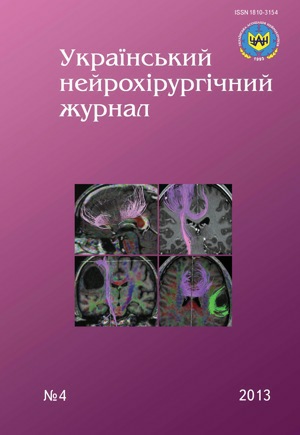Radiofrequency neurotomy in patients with cervical pain syndrome
DOI:
https://doi.org/10.25305/unj.55408Keywords:
cervical spine, pain in the neck, shoulders and upper limbs, radiofrequency neurotomyAbstract
Introduction. Chronic pain in the neck, shoulders and upper limbs is often at degenerative changes of cervical spine joints.
The purpose. Study efficacy of radiofrequency neurotomy of medial branch of spinal nerve dorsal root of cervical spine in patients with pain in the neck, shoulders and upper limbs, factors that could affect the outcome were analyzed.
Materials and methods. Demographic data, types of pain location, the response to double control block, electrical stimulation parameters, the number and level of neurotomy, results of surgical treatment were studied during 12 months after surgery. Electrical stimulation intensity was from 0.3 to 0.69 V, an average — 0.45 V (to origin of pain specific for the patient).
Results. In 19 (68%) among 28 patients satisfactory results were achieved, in 8 (42%) — pain disappeared completely. In 4 patients pain recrudesced in 6–12 months.
Conclusions. Neurotomy of spinal nerve medial branch is an effective method for treatment of pain in the neck, shoulders and upper limbs in patients with degenerative changes in cervical spine joints.References
1. Bogduk N, Marsland A. The cervical zygapophysial joints as a source of neck pain. Spine (Phila Pa 1976). 1988 Jun;13(6):610-7. [CrossRef] [PubMed]
2. Yin W, Bogduk N. The nature of neck pain in a private pain clinic in the United States. Pain Med. 2008 Mar;9(2):196-203. [CrossRef] [PubMed]
3. Boswell MV, Trescot AM, Datta S, Schultz DM, Hansen HC, Abdi S, Sehgal N, Shah RV, Singh V, Benyamin RM, Patel VB, Buenaventura RM, Colson JD, Cordner HJ, Epter RS, Jasper JF, Dunbar EE, Atluri SL, Bowman RC, Deer TR, Swicegood JR, Staats PS, Smith HS, Burton AW, Kloth DS, Giordano J, Manchikanti L; American Society of Interventional Pain Physicians. Interventional techniques: evidence-based practice guidelines in the management of chronic spinal pain. Pain Phys. 2007 Jan;10(1):7-111. [PubMed]
4. Peloso P, Gross A, Haines T, Trinh K, Goldsmith CH, Burnie S; Cervical Overview Group. Medicinal and injection therapies for mechanical neck disorders. Cochrane Database Syst Rev. 2007 Jul 18;(3):CD000319. [PubMed]
5. Manchikanti L, Manchikanti KN, Cash KA, Singh V, Giordano J. Age-related prevalence of facet-joint involvement in chronic neck and low back pain. Pain Phys. 2008 Jan;11(1):67-75. [PubMed]
6. Manchikanti L, Singh V, Derby R, Schultz DM, Benyamin RM, Prager JP, Hirsch JA. Reassessment of evidence synthesis of occupational medicine practice guidelines for interventional pain management. Pain Physician. 2008 Jul-Aug;11(4):393-482. [PubMed]
7. Schunemann HJ, Oxman AD, Brozek J, Glasziou P, Jaeschke R, Vist GE, Williams JW Jr, Kunz R, Craig J, Montori VM, Bossuyt P,Guyatt GH; GRADE Working Group. Grading quality of evidence and strength of recommendations for diagnostic tests and strategies. BMJ. 2008 May 17;336(7653):1106-10. [CrossRef] [PubMed]
8. Shin WR, Kim HI, Shin DG, Shin DA. Radiofrequency neurotomy of cervical medial branches for chronic cervicobrachialgia. J Korean Med Sci. 2006 Feb;21(1):119-25. [CrossRef] [PubMed]
9. Barnsley L, Lord S, Wallis B, Bogduk N. False-positive rates of cervical zygapophysial joint blocks. Clin J Pain. 1993 Jun;9(2):124-30. [CrossRef] [PubMed]
10. Barnsley L. Percutaneous radiofrequency neurotomy for chronic neck pain: outcomes in a series of consecutive patients. Pain Med. 2005 Jul-Aug;6(4):282-6. [CrossRef] [PubMed]
Downloads
Published
How to Cite
Issue
Section
License
Copyright (c) 2013 Vakhtang Sichinava, Anatoliy Korotkoruchko, Mykola Polishchuk

This work is licensed under a Creative Commons Attribution 4.0 International License.
Ukrainian Neurosurgical Journal abides by the CREATIVE COMMONS copyright rights and permissions for open access journals.
Authors, who are published in this Journal, agree to the following conditions:
1. The authors reserve the right to authorship of the work and pass the first publication right of this work to the Journal under the terms of Creative Commons Attribution License, which allows others to freely distribute the published research with the obligatory reference to the authors of the original work and the first publication of the work in this Journal.
2. The authors have the right to conclude separate supplement agreements that relate to non-exclusive work distribution in the form of which it has been published by the Journal (for example, to upload the work to the online storage of the Journal or publish it as part of a monograph), provided that the reference to the first publication of the work in this Journal is included.









